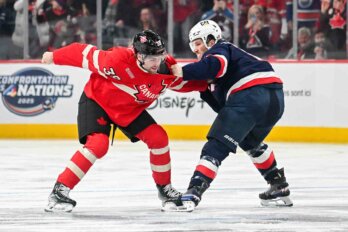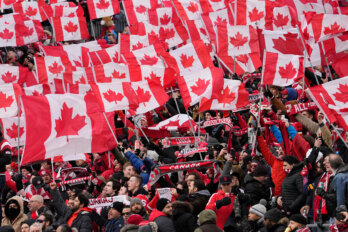Twenty years ago, the Baltimore Stallions beat the Calgary Stampeders and took the Grey Cup away from Canada for the first time. It was also the last time—but at the time, losing the Grey Cup was everything.
Barry Levinson’s 1982 film Diner, beyond launching the careers of a slew of young actors, introduced a classic sports scene to cinema: the one where Steve Guttenberg’s character Eddie Simmons proctors a 140-question football quiz that his fiancée Elyse must pass before he will marry her. She succeeds, but it’s not without controversy (and where is her quiz for him, by the way? Nowhere, because the film takes place in the late 1950s). Diner is set in Baltimore the year after “The Greatest Game Ever Played,” in which the hometown Colts beat the New York Giants for the 1958 National Football League championship; the film culminates with the Colts repeating as champions during Eddie and Elyse’s wedding, with the team’s blue and white as the couple’s colours.
Despite the celebratory ending, Diner was nonetheless a nostalgic look back on glories past. While Levinson was filming, the Colts were a dismal 2–14. The year the film came out, they were 0–8–1 in a (thankfully, for them) strike-shortened season. Two years later, the Colts were gone, having moved to Indianapolis contemptibly in the middle of the night.
For years, Baltimore tried to lure another team back, watching helplessly as the St. Louis Cardinals (football, not baseball) moved to Phoenix, the Los Angeles Raiders moved back to Oakland, and the Los Angeles Rams replaced the Cardinals in St. Louis; expansion franchises were awarded not to Baltimore, but to Jacksonville, Florida and Charlotte, North Carolina. After being passed over by the NFL, however, the city got a consolation of sorts from the Canadian Football League, which awarded Baltimore a CFL franchise for the 1994 season.
Baltimore’s team was barred from using the Colts nickname by ongoing litigation, so they were referred to with generic nomenclature (the CFLs, the CFLers, the Baltimore Football Club)—but with Colts always implied. The new team retained many of the old traditions, including the famous Baltimore Colts’ Marching Band, which hadn’t followed the Colts to Indianapolis and instead roamed the country in the intervening years like ronin drum majors. The band didn’t necessarily feel privileged by its new assignment: In the ESPN documentary The Band That Wouldn’t Die (also directed by Levinson), a longstanding member declares, “Do you know what it was like to sit there and watch Canadian football? Awful—it was awful.” Two other band members pipe in that they actually started to like it toward the end, but, really, the CFL would never be better than second-rate to them. It would never be more than “cute” (the most famous CFL fan in the United States might have been Seinfeld’s Cosmo Kramer—because he was an eccentric). American football didn’t understand that a fan in Edmonton might just live and die with the Eskimos, like the proverbial billion people in China who don’t care what happens over here. It wouldn’t understand that Edmonton doesn’t need a National Football League team to cheer for . . . unless Calgary has one.
It wasn’t so surprising that the Canadian game was going south in the mid-1990s, because everything else was—starting with the dollar. The smaller Canadian NHL franchises were on shaky ground, and the Quebec Nordiques would soon move to Colorado, followed by the Winnipeg Jets to Phoenix (it was astonishingly suggested by some that in the end, the Toronto Maple Leafs would be the only Canadian NHL team left). Soon the vultures would be swirling around the Montreal Expos after the devastating Major League Baseball players’ strike of 1994 and the club’s gutting of its roster. The National Basketball Association’s Grizzlies were about to embark on their own hardly knew ye in Vancouver: Before the decade was over Steve Francis would refuse to play for the team after being drafted second overall, and within a few more years they’d be playing home games in Memphis. The MLB championship the Toronto Blue Jays won in the autumn of 1993, so feted this past baseball season, remains the last title a major Canadian professional team has won outside of the CFL. Perhaps the worst indignity of all would be losing the Grey Cup to a country that didn’t much want the Canadian brand of football, or its hallowed trophy.
During the CFL’s US expansion, the American teams didn’t have a quota for Canadian players, while their northern competitors were required to have ten—an immense advantage for any American franchise that figured it out. It was a deal with the devil to make expansion succeed, and as usual, the devil came wearing a familiar face. Baltimore was coached by Don Matthews, who had been the defensive coordinator of the Eskimos dynasty that won five consecutive Grey Cups from 1978–1982, and had previously been head coach in both Saskatchewan and BC. Though most American football fans know little about the CFL, for generations the league itself has been full of Americans that know the game—because they’ve played it, or have coached it, or both. The expansion teams would have done well to remember this, but instead they generally hired coaches with what they considered to be superior American collegiate and professional bona fides. In fact, of the six US franchises that played in the CFL (note: Sacramento and San Antonio count as one), only one of them announced an inaugural head coach with actual CFL coaching experience. Matthews had won his most recent Grey Cup in 1985 as head coach of the BC Lions, and it was going to be up to those same Lions to stop him in 1994, after Toronto (the franchise with the most Grey Cup titles) and Winnipeg (the defending East Division champions) failed to stymie the incursion from the south (insert War of 1812 reference here).
Despite the CFL’s recent three-year run of teams winning the Grey Cup on their home field (the Lions in 2011, the Argos in 2012, and the Roughriders in 2013), in 1994 the BC Lions facing a nameless team from Baltimore on their home field in Vancouver was a rare spectacle, even without the border war. During the 1994 broadcast itself, the commentators mentioned how infrequent it was—and especially infrequent to win: “Since 1950, eight teams have hosted their own Grey Cup, but only three have won.” It was the perfect setup, and the game delivered, with BC winning on Lui Passaglia’s field goal with straight zeroes on the clock.
Passaglia was named the day’s Most Outstanding Canadian, but the game also featured other classic CFL tropes: journeymen, second chances, and the opportunity for great college quarterbacks to continue their careers on the field. The misconception, though, is that any failed NFL quarterback is a candidate for the CFL—last year, the sports pundit Bill Simmons criticized both Colin Kaepernick and Geno Smith in the same podcast by calling them future CFL players—but while most CFL quarterbacks wouldn’t succeed in the NFL, success in the Canadian league requires more than just being inadequate south of the border. Another reason why CFL fans enjoyed the Lions victory.
But the American foe hadn’t been vanquished forever, and the problem remained that Baltimore was still really, really good. In 1995, they finally had a name: the Stallions, because close enough. For the team itself, though, losing a championship game with no time remaining was not close enough, and in 1995, Baltimore was determined. They began to gather a head of steam after a false start in week one, when they were edged by three points in rematch to the Lions. They lost only two more games that season, one against Calgary (a foreshadowing), the other to Memphis, because—wait—Memphis had a CFL team before they had the Grizzlies? (Yes, the Mad Dogs.)
For the 1995 season, the CFL had realigned its divisions into North and South, reminiscent of when the NHL put all of its 1967 expansion teams in the same division (the West) in order to guarantee the new markets some success. In that case, it just resulted in three straight losses by the expansion St. Louis Blues in the finals to great NHL powers, while the Eastern final became hockey’s de facto championship. In the CFL’s case, however, realignment instituted in a path-of-least-resistance for the Stallions. Calgary won a sort of mini Grey Cup by beating archrival Edmonton in the Western Division Final, but unlike those old hockey teams facing the Blues, the Stampeders faced no pushover for the championship.
This was to be a battle of two evenly matched teams. Both had 15–3 records to finish the regular season. Both, obviously, had equine nicknames—which was fine for the CFL since there were still two other teams with nearly identical names (the Saskatchewan Roughriders and the Ottawa Rough Riders). But the horse’s mane in one of the logos invoked the stars and stripes, so the fans north of the border knew which horse in the race was theirs. And this time, the game wouldn’t be inside the preferred convention spaces of BC Place or SkyDome—but outside in the CFL’s heartland at Taylor Field in Regina.
Incredibly, it was Saskatchewan’s first time hosting the big game, and this was to be the ultimate home-field advantage. It was cold, and it was windy. A friend of mine who occasionally wore ski goggles as a humourous style choice (hey, it was the nineties) actually wore them out of necessity. The Canadian team was supposed to be in its element, and briefly appeared to be when the Stampeders took the lead at the opening of the second quarter on Doug Flutie’s touchdown pass to Marvin Pope. But that was the high point for Calgary. Baltimore scored four times before the half was through, and effectively controlled the game from then on. It was, for the most part, an excruciating smothering of hope for viewers across Canada. Really, though, one question haunts this game for me: Dwayne “The Rock” Johnson was on the Stampeders’ practice roster at the beginning of the season. If he had hung on, could he have made the difference?
It wasn’t just Canadians who suffered, though, as the eighty-third Grey Cup ended up as a bittersweet victory for the fans who had truly adopted the Stallions. Baltimore had led the CFL in attendance that year, which made a strong case to the NFL and was music to the ears of Art Modell, the longtime Cleveland Browns owner who was looking for a sweeter deal than what he had on the shores of Lake Erie. At the beginning of the 1995 CFL playoffs, he announced that he’d be moving his Browns, soon renamed the Ravens, to Baltimore. Some fans responded during the CFL playoffs (signs read, “Save Our Stallions” and “To Hell with Art Modell”), but everyone knew that the NFL was king, and it effectively let the air out of the Stallions’ balloon. They would lose all but their die-hard fans, and came home to no civic championship parade. Within weeks the city had gone back to its one true love, with the Stallions reduced to a seat-warmer between the beloved Colts and the two-time Super Bowl champion Ravens.
Seeing the writing on the wall, Stallions owner Jim Speros moved his club to Montreal, technically becoming the city’s third CFL franchise, after the original Alouettes and the Concordes. As the lone titleholders from a willfully forgotten American expansion, the Stallions are usually buried as a footnote in the backstory of the reincarnated Alouettes, and are not even part of the franchise’s official history. But nonetheless, in a reverse brain drain, Montreal imported the best franchise in the league, one that would make the Grey Cup eight times in the next fourteen years, winning three of them, and in the process reigniting a Grey Cup rivalry with the Eskimos that had been the hallmark of both the 1950s and 1970s.
In the end, per the equation tragedy + time = comedy, it can be fun to look back on the expansion now, since Baltimore has been made whole (at the expense of Cleveland for a while), and the importation of one strong franchise to Canada has done more for the CFL than the US expansion in its entirety. I had watched games at Montreal’s Percival Molson Memorial Stadium when the tree still grew through the stands on the north side, and I was sitting in my nearby apartment in the autumn of 1997 when I suddenly noticed an epic traffic jam outside as the Alouettes fans descended on the neighbourhood for the first time in modern memory. Famously banished from Olympic Stadium by U2’s PopMart concert tour, the Als beat the Lions in the opening round of the playoffs, winning their first game at Molson Stadium since 1972, when the Sam Etcheverry-coached Als had beaten Edmonton for their last victory of the season. The game went back outside in Montreal, and like the success of Regina’s first Grey Cup, it took the CFL back to roots the league had previously ignored. Since 1995, the Prairies have hosted ten Grey Cups compared to the four they’d hosted of the first eighty-two contests. They host an eleventh this Sunday in Winnipeg, and next year, while the Grey Cup is back in Toronto for the forty-eighth time, the game is going back outside (at BMO Field) for the first time since 1982. The league still faces challenges, but the challenges are its own, and for those for whom the Grey Cup is still appointment viewing—while everyone else is watching the late afternoon NFL games lead up to the Patriots and Broncos in Denver—they have a date in Winnipeg.





